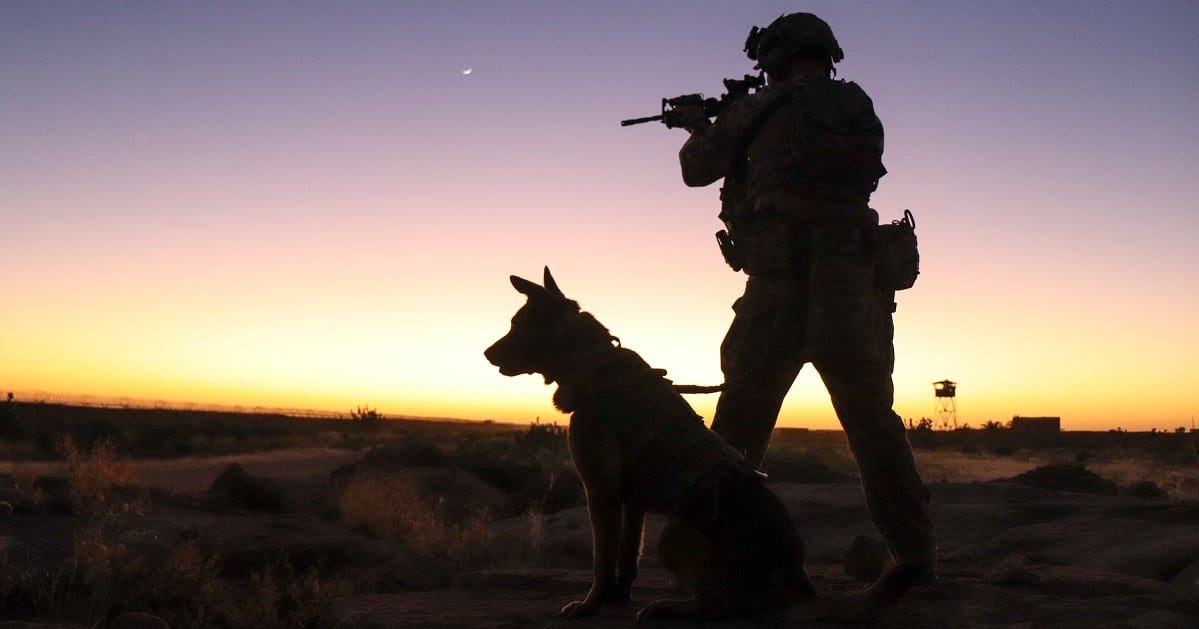The government’s first in-depth examination in 15 years of domestically bred working dogs is warning that the U.S. remains dangerously short of this key frontline defense against terrorism attacks and for critical security duties, such as bomb sniffing and narcotics interdiction
The federal government, the U.S. Navy’s Naval Post Graduate School found, “has faced a chronic shortage of domestically bred working dogs qualified for use by both the Department of Defense and other federal agencies. As adversaries, both peer and near-peer, become more adept in circumventing detection systems, the need for working dogs has steadily increased to address security vulnerabilities.”
“The lack of a robust domestic supply of working dogs creates increased supply chain risk and may threaten the ability of departments and agencies that utilize working dogs to maintain readiness if the supply from foreign markets is contested or interrupted for an extended period,” the little-noticed 157-page report concluded.
The problem has been kicking around Capitol Hill for several years. Back in 2017, Rep. Mike Rogers, R-Ala., succinctly captured the pressing need for correcting the security deficit. “I don’t think the public understands how scarce this resource is,” said Rogers, who serves on the Homeland Security Committee, “and how critically important it is to our national security.”
The issue is slowly beginning to receive the high-level attention it deserves. Sen. Richard Blumenthal, D-Conn., a member of the Senate Armed Services Committee, authored a measure in the annual defense authorization bill that supports assessing the outlines of a program to breed military working dogs domestically.
“I was surprised to learn from the Air Force that the vast majority of our working dogs are actually born and bred in Europe, which raises costs and puts us in competition with other countries,” Blumenthal said.
RELATED

One reason for the shortage of domestically bred working dogs for these vital roles is familiar to most any government contractor: an impenetrable bureaucracy and lack of transparency.
Many domestic canine breeders have the capability to produce exceptional working dogs, the report found, but the “onerous procurement process of the government discourages vendors from supplying canines to the government sector of the market. The nonstandard requirements, evaluation system, and— most importantly — the uncertainty of the government’s future demand for working dogs makes it difficult for vendors to continue doing business with the government.”
While electronics generally define high technology, detection technology is an outlier: no man-made technology can come close to the detection capabilities of highly trained, purpose-bred canines.
Certainly, that is true when considering the range of security roles that these dogs serve. They are also used to detect smuggled people, narcotics, currency, firearms, electronics, chemicals associated with weapons of mass destruction and are used in search-and-rescue missions. They are employed across facilities, public buildings and localities, around the nation.
The U.S. rarely, if ever, cedes critical national security duties to foreign manufacturers. From fighter jets to submarines to tanks, the default is to U.S. suppliers. But when it comes to the dogs that safeguard millions of people annually, some 93 percent are obtained from foreign vendors or domestic vendors who import dogs bred overseas, according to the report.
The federal government currently maintains approximately 5,000 working dogs across four departments — the Departments of Defense, Homeland Security, Justice and State. But only 7 percent are bred domestically, and the rest are imported from Europe, the report found. Another estimated 5,000 working dogs are deployed across local law enforcement and private facilities, with a similar low percentage bred domestically.
The best dogs tend to be retained for use in Europe, where they are bred. And the U.S. finds itself in the position of competing against military peer competitors Russia and China for the same dogs in the same markets.
The supply of capable working dogs from foreign sources is continuing to tighten. The threat of terrorism and resulting demand for working dogs within Europe and around the world means there’s a growing shortage of even mediocre-quality foreign dogs available to protect the U.S.
The Department of Defense maintains a modest breeding program at its kennels at Lackland Air Force Base in San Antonio, far from sufficient to meet domestic demand.
Breeders, researchers and government agencies have committed to addressing this security deficit. In addition, the Biden administration has stressed a renewed commitment to U.S.-made goods and services in federal procurement. Which is why one of the top priorities of the new administration and the congressional defense committees should be implementing a less convoluted procurement process.
“While working dogs and their procurement do not generally make the headlines in the news, their importance should not be underestimated,” the report summarizes. “Despite continual and rapid advances in technology, working dogs remain a vital and irreplaceable asset to national security.”
Let’s hope that Congress and the new administration are listening.
Goffe is vice president, government relations for the American Kennel Club.
Editor’s note: This is an op-ed and as such, the opinions expressed are those of the author. If you would like to respond, or have an editorial of your own you would like to submit, please contact Military Times managing editor Howard Altman, haltman@militarytimes.com.





